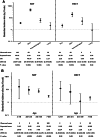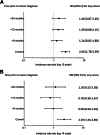"Risk of de novo or secondary cancer after solid organ or allogeneic haematopoietic stem cell transplantation"
- PMID: 31587105
- PMCID: PMC11810276
- DOI: 10.1007/s00432-019-03039-2
"Risk of de novo or secondary cancer after solid organ or allogeneic haematopoietic stem cell transplantation"
Abstract
Purpose: Solid organ (SOT) and allogeneic haematopoietic stem cell (HSCT) transplant recipients have elevated risks of de novo or secondary cancer. We explored risk factors hereof.
Methods: Among SOT and HSCT between January 2004 and December 2014, standardised incidence ratio (SIR) of de novo/secondary cancer compared with the Danish population was determined and risk factors were identified using Poisson regression.
Results: During a median of 3.4 (IQR 1.3-6.4) and 2.6 (0.8-5.4) person-years (PY) after SOT and HSCT, a total of 212/1656 (13%) and 75/992 (8%) persons developed cancer; SIR 3.61 (3.0-4.3) and 2.2 (1.6-3.0), resp.). SIR correlated with younger age and was highest for skin and haematological cancers for both types of transplantation. Within the cohort, cancer was associated with older age (adjusted incidence rate ratio > 50 vs ≤ 19 years, among SOT and HSCT: 9.4 (3.4-25.7) and 25.4 (5.1-126.0), resp.) and current elevated C-reactive protein (CRP) (≥ 10 vs < 10 mg/L: 2.5 (1.8-3.4) and 2.3 (1.4-3.9), resp.), but neither with prior cancer nor type of immunosuppressants.
Conclusion: Rates of de novo or secondary cancers are elevated in both SOT and HSCT compared with the general population and mainly for skin and haematological cancers. Among transplant recipients, older age and current elevated CRP are risk factors.
Keywords: Cancer; Inflammation; Secondary cancer; Transplantation.
Conflict of interest statement
The authors declare that they have no conflict of interest.
Figures


Similar articles
-
The value of EBV DNA in early detection of post-transplant lymphoproliferative disorders among solid organ and hematopoietic stem cell transplant recipients.J Cancer Res Clin Oncol. 2018 Aug;144(8):1569-1580. doi: 10.1007/s00432-018-2674-9. Epub 2018 May 26. J Cancer Res Clin Oncol. 2018. PMID: 29804164 Free PMC article.
-
Bone marrow versus peripheral blood allogeneic haematopoietic stem cell transplantation for haematological malignancies in adults.Cochrane Database Syst Rev. 2024 Nov 7;11(11):CD010189. doi: 10.1002/14651858.CD010189.pub3. Cochrane Database Syst Rev. 2024. PMID: 39508306
-
First-line allogeneic hematopoietic stem cell transplantation of HLA-matched sibling donors compared with first-line ciclosporin and/or antithymocyte or antilymphocyte globulin for acquired severe aplastic anemia.Cochrane Database Syst Rev. 2013 Jul 23;2013(7):CD006407. doi: 10.1002/14651858.CD006407.pub2. Cochrane Database Syst Rev. 2013. PMID: 23881658 Free PMC article.
-
Restrictive versus liberal red blood cell transfusion strategies for people with haematological malignancies treated with intensive chemotherapy or radiotherapy, or both, with or without haematopoietic stem cell support.Cochrane Database Syst Rev. 2017 Jan 27;1(1):CD011305. doi: 10.1002/14651858.CD011305.pub2. Cochrane Database Syst Rev. 2017. Update in: Cochrane Database Syst Rev. 2024 May 23;5:CD011305. doi: 10.1002/14651858.CD011305.pub3. PMID: 28128441 Free PMC article. Updated.
-
Cancer risk in people living with HIV and solid organ transplant recipients: a systematic review and meta-analysis.Lancet Oncol. 2024 Jul;25(7):933-944. doi: 10.1016/S1470-2045(24)00189-X. Lancet Oncol. 2024. PMID: 38936380 Free PMC article.
Cited by
-
Management of Post-transplant Infections in Collaborating Hospitals (MATCH) Programme: a prospective cohort of all transplant recipients at Copenhagen University Hospital-Rigshospitalet, Denmark.BMJ Open. 2024 Nov 13;14(11):e089966. doi: 10.1136/bmjopen-2024-089966. BMJ Open. 2024. PMID: 39537569 Free PMC article.
-
Cancer incidence in immunocompromised patients: a single-center cohort study.BMC Cancer. 2023 Jan 9;23(1):33. doi: 10.1186/s12885-022-10497-4. BMC Cancer. 2023. PMID: 36624408 Free PMC article.
-
Immune Activation, Exhaustion and Senescence Profiles as Possible Predictors of Cancer in Liver Transplanted Patients.Front Oncol. 2022 Jun 13;12:899170. doi: 10.3389/fonc.2022.899170. eCollection 2022. Front Oncol. 2022. PMID: 35769714 Free PMC article.
-
Early- and late-onset posttransplant lymphoproliferative disorders among adult kidney and liver transplant recipients.Eur J Haematol. 2022 Oct;109(4):343-350. doi: 10.1111/ejh.13815. Epub 2022 Jul 14. Eur J Haematol. 2022. PMID: 35719018 Free PMC article.
-
Cancer Risks in Solid Organ Transplant Recipients: Results from a Comprehensive Analysis of 72 Cohort Studies.Oncoimmunology. 2020 Nov 29;9(1):1848068. doi: 10.1080/2162402X.2020.1848068. Oncoimmunology. 2020. PMID: 33299661 Free PMC article.
References
-
- Aagaard T, Reekie J, Roen A, Daugaard G, Specht L, Sengelov H et al (2019) Development and validation of a cycle-specific risk score for febrile neutropenia during chemotherapy cycles 2-6 in patients with solid cancers: the (CSR) FENCE score. Int J Cancer. 10.1002/ijc.32249 - PubMed
-
- Allin KH, Bojesen SE, Nordestgaard BG (2009) Baseline C-reactive protein is associated with incident cancer and survival in patients with cancer. J Clin Oncol 27(13):2217–2224 - PubMed
-
- Allin KH, Bojesen SE, Nordestgaard BG (2016) Inflammatory biomarkers and risk of cancer in 84,000 individuals from the general population. Int J Cancer 139(7):1493–1500 - PubMed
-
- Billups K, Neal J, Salyer J (2015) Immunosuppressant-driven de novo malignant neoplasms after solid-organ transplant. Prog Transplant 25(2):182–188 - PubMed
MeSH terms
Substances
Grants and funding
LinkOut - more resources
Full Text Sources
Medical
Research Materials
Miscellaneous

